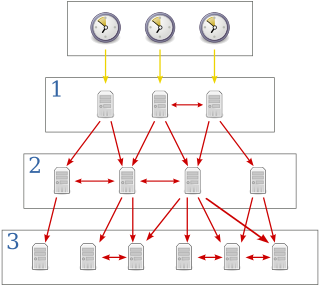Related Research Articles
International Atomic Time is a high-precision atomic coordinate time standard based on the notional passage of proper time on Earth's geoid. TAI is a weighted average of the time kept by over 450 atomic clocks in over 80 national laboratories worldwide. It is a continuous scale of time, without leap seconds, and it is the principal realisation of Terrestrial Time. It is the basis for Coordinated Universal Time (UTC), which is used for civil timekeeping all over the Earth's surface and which has leap seconds.
Linear Timecode (LTC) is an encoding of SMPTE timecode data in an audio signal, as defined in SMPTE 12M specification. The audio signal is commonly recorded on a VTR track or other storage media. The bits are encoded using the biphase mark code : a 0 bit has a single transition at the start of the bit period. A 1 bit has two transitions, at the beginning and middle of the period. This encoding is self-clocking. Each frame is terminated by a 'sync word' which has a special predefined sync relationship with any video or film content.

A leap second is a one-second adjustment that is occasionally applied to Coordinated Universal Time (UTC), to accommodate the difference between precise time and imprecise observed solar time (UT1), which varies due to irregularities and long-term slowdown in the Earth's rotation. The UTC time standard, widely used for international timekeeping and as the reference for civil time in most countries, uses TAI and consequently would run ahead of observed solar time unless it is reset to UT1 as needed. The leap second facility exists to provide this adjustment. The leap second was introduced in 1972 and since then 27 leap seconds have been added to UTC.
MIDI time code (MTC) embeds the same timing information as standard SMPTE timecode as a series of small 'quarter-frame' MIDI messages. There is no provision for the user bits in the standard MIDI time code messages, and SysEx messages are used to carry this information instead. The quarter-frame messages are transmitted in a sequence of eight messages, thus a complete timecode value is specified every two frames. If the MIDI data stream is running close to capacity, the MTC data may arrive a little behind schedule which has the effect of introducing a small amount of jitter. In order to avoid this it is ideal to use a completely separate MIDI port for MTC data. Larger full-frame messages, which encapsulate a frame worth of timecode in a single message, are used to locate to a time while timecode is not running.

A time zone is an area which observes a uniform standard time for legal, commercial and social purposes. Time zones tend to follow the boundaries between countries and their subdivisions instead of strictly following longitude, because it is convenient for areas in frequent communication to keep the same time.

Vertical Interval Timecode is a form of SMPTE timecode encoded on one scan line in a video signal. These lines are typically inserted into the vertical blanking interval of the video signal.

A time standard is a specification for measuring time: either the rate at which time passes or points in time or both. In modern times, several time specifications have been officially recognized as standards, where formerly they were matters of custom and practice. An example of a kind of time standard can be a time scale, specifying a method for measuring divisions of time. A standard for civil time can specify both time intervals and time-of-day.

The Network Time Protocol (NTP) is a networking protocol for clock synchronization between computer systems over packet-switched, variable-latency data networks. In operation since before 1985, NTP is one of the oldest Internet protocols in current use. NTP was designed by David L. Mills of the University of Delaware.

SMPTE timecode is a set of cooperating standards to label individual frames of video or film with a timecode. The system is defined by the Society of Motion Picture and Television Engineers in the SMPTE 12M specification. SMPTE revised the standard in 2008, turning it into a two-part document: SMPTE 12M-1 and SMPTE 12M-2, including new explanations and clarifications.
The Time from NPL is a radio signal broadcast from the Anthorn Radio Station near Anthorn, Cumbria, which serves as the United Kingdom's national time reference. The time signal is derived from three atomic clocks installed at the transmitter site, and is based on time standards maintained by the UK's National Physical Laboratory (NPL) in Teddington. The service is provided by Babcock International, under contract to the NPL. It was funded by the former Department for Business, Innovation and Skills; as of 2017 NPL Management Limited (NPLML) was owned by the Department for Business, Energy and Industrial Strategy (BEIS), and NPL operated as a public corporation.

WWV is a shortwave radio station, located near Fort Collins, Colorado. It has broadcast a continuous time signal since 1945, and implements United States government frequency standards, with transmitters operating on 2.5, 5, 10, 15, and 20 MHz. WWV is operated by the U.S. National Institute of Standards and Technology (NIST), under the oversight of its Time and Frequency Division, which is part of NIST's Physical Measurement Laboratory based in Gaithersburg, Maryland.
WWVB is a time signal radio station near Fort Collins, Colorado and is operated by the National Institute of Standards and Technology (NIST). Most radio-controlled clocks in North America use WWVB's transmissions to set the correct time. The 70 kW ERP signal transmitted from WWVB is a continuous 60 kHz carrier wave, the frequency of which is derived from a set of atomic clocks located at the transmitter site, yielding a frequency uncertainty of less than 1 part in 1012. A one-bit-per-second time code, which is based on the IRIG "H" time code format and derived from the same set of atomic clocks, is then modulated onto the carrier wave using pulse-width modulation and amplitude-shift keying. A single complete frame of time code begins at the start of each minute, lasts one minute, and conveys the year, day of year, hour, minute, and other information as of the beginning of the minute.
JJY is the call sign of a low frequency time signal radio station located in Japan.

DCF77 is a German longwave time signal and standard-frequency radio station. It started service as a standard-frequency station on 1 January 1959. In June 1973 date and time information was added. Its primary and backup transmitter are located at 50°0′56″N9°00′39″E in Mainflingen, about 25 km south-east of Frankfurt am Main, Germany. The transmitter generates a nominal power of 50 kW, of which about 30 to 35 kW can be radiated via a T-antenna.
Inter-range instrumentation group timecodes, commonly known as IRIG timecode, are standard formats for transferring timing information. Atomic frequency standards and GPS receivers designed for precision timing are often equipped with an IRIG output. The standards were created by the Tele Communications Working Group of the U.S. military's Inter-Range Instrumentation Group (IRIG), the standards body of the Range Commanders Council. Work on these standards started in October 1956, and the original standards were accepted in 1960.

Unix time is a date and time representation widely used in computing. It measures time by the number of seconds that have elapsed since 00:00:00 UTC on 1 January 1970, the Unix epoch, without adjustments made due to leap seconds. In modern computing, values are sometimes stored with higher granularity, such as microseconds or nanoseconds.

ALS162 is a French longwave time signal and standard-frequency radio station and is used for the dissemination of the Metropolitan French national legal time to the public. TéléDiffusion de France broadcast the ALS162 time signal, provided by LNE-SYRTE and LNE-LTFB time laboratories under ANFR responsibility, from the Allouis longwave transmitter at 162 kHz, with a power of 800 kW.

A phasor measurement unit (PMU) is a device used to estimate the magnitude and phase angle of an electrical phasor quantity in the electricity grid using a common time source for synchronization. Time synchronization is usually provided by GPS or IEEE 1588 Precision Time Protocol, which allows synchronized real-time measurements of multiple remote points on the grid. PMUs are capable of capturing samples from a waveform in quick succession and reconstructing the phasor quantity, made up of an angle measurement and a magnitude measurement. The resulting measurement is known as a synchrophasor. These time synchronized measurements are important because if the grid’s supply and demand are not perfectly matched, frequency imbalances can cause stress on the grid, which is a potential cause for power outages.

Coordinated Universal Time or UTC is the primary time standard by which the world regulates clocks and time. It is within about one second of mean solar time at 0° longitude and is not adjusted for daylight saving time. It is effectively a successor to Greenwich Mean Time (GMT).
BSF is the callsign of the time signal transmitter owned by the National Time and Frequency Standards Laboratory of the Ministry of Economic Affairs (Taiwan), which transmits time information on 77.5 kHz in the longwave range. It was launched on May 1, 1969 and is broadcast from Zhongli District in Taichung using a T-antenna located at 25°0′20″N121°21′54″E.
References
- ↑ A New View of the Power System https://www.selinc.com/WorkArea/DownloadAsset.aspx?id=132 Archived 2015-04-23 at the Wayback Machine
- ↑ IEEE Digital Library http://ieeexplore.ieee.org/xpl/freeabs_all.jsp?arnumber=943067&isnumber=20419
- ↑ IRIG standard 200-04 (PDF) "Archived copy" (PDF). Archived from the original (PDF) on 2011-07-22. Retrieved 2010-08-03.
{{cite web}}: CS1 maint: archived copy as title (link) - ↑ IEEE Std 1344-1995 (Excerpts) (PDF), IEEE, 1995, archived from the original (PDF) on 2012-04-02, retrieved 2011-09-24
- ↑ Rana, Ankur Singh; Parveen, Nisha; Rasheed, Shaziya; Thomas, Mini S. (December 2015). "Exploring IEEE standard for synchrophasor C37.118 with practical implementation". 2015 Annual IEEE India Conference (INDICON). pp. 1–6. doi:10.1109/INDICON.2015.7443664. ISBN 978-1-4673-7399-9. S2CID 45765678.
- ↑ (Draft) Standard for Synchrophasors for Power Systems